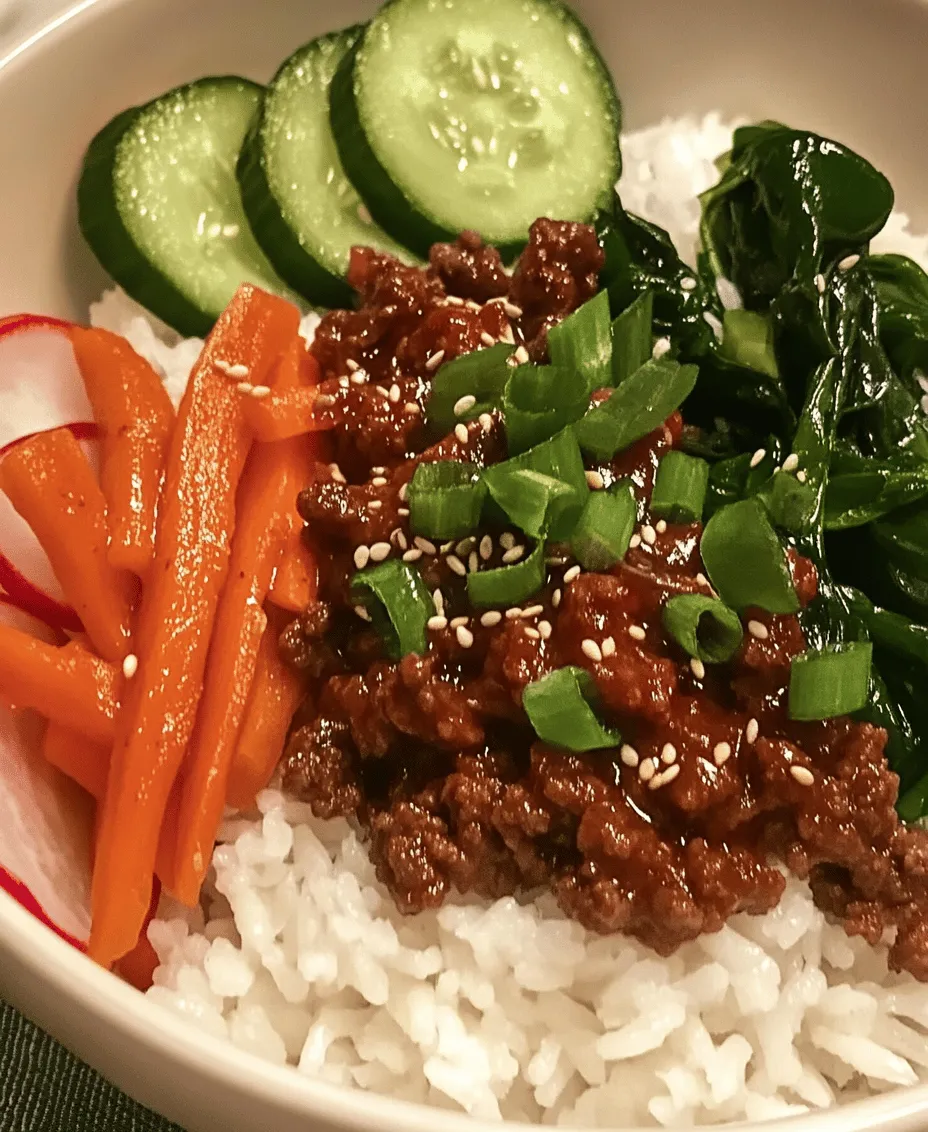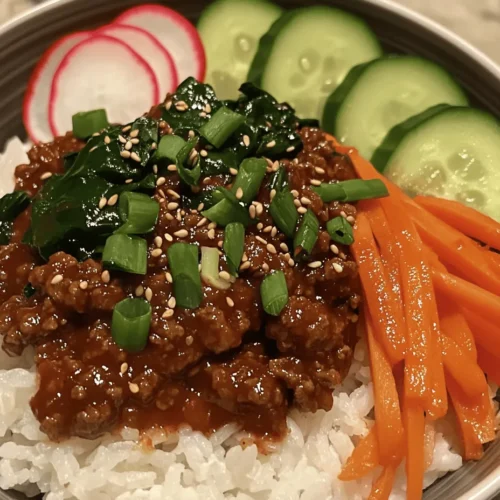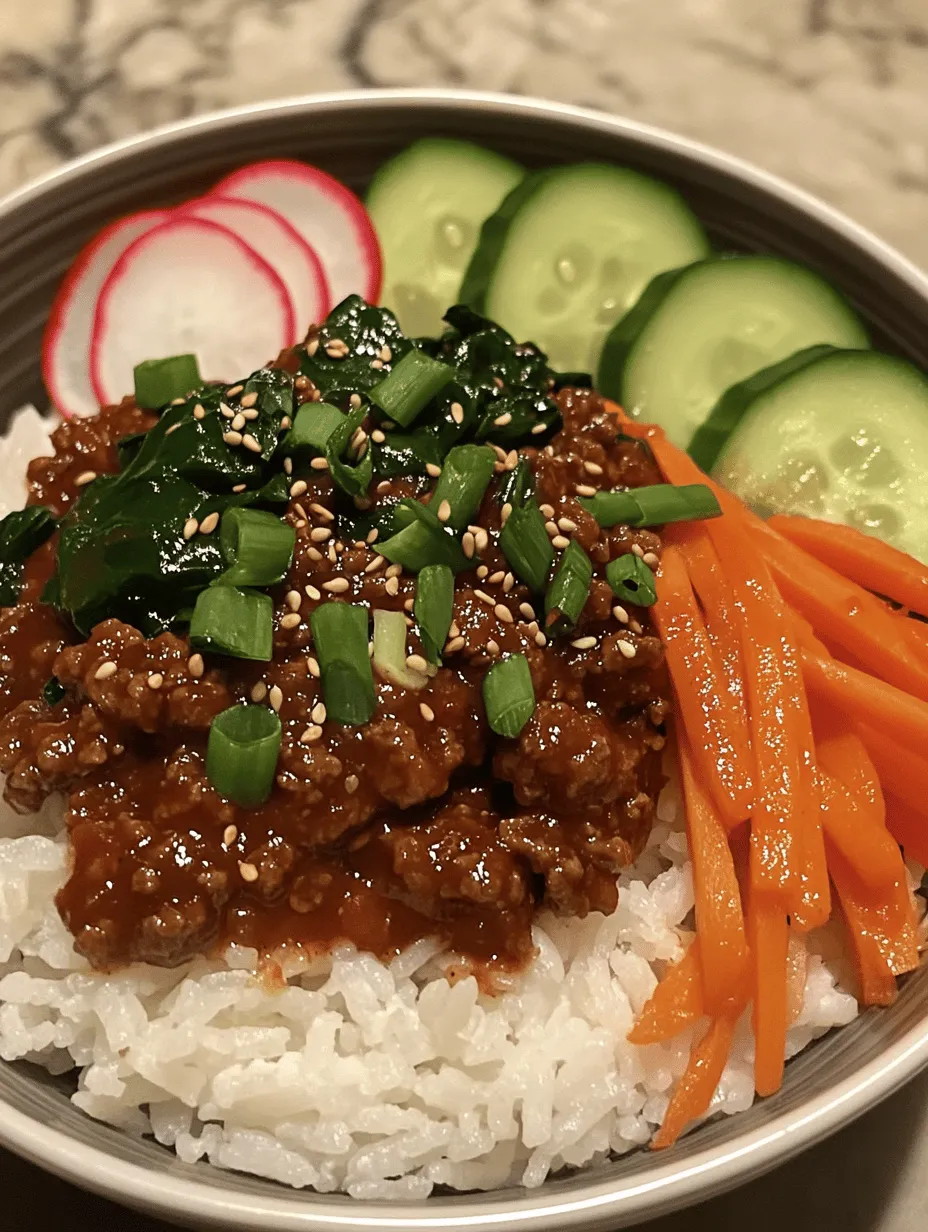Introduction
Korean cuisine has taken the culinary world by storm, celebrated for its vibrant flavors and unique combinations of ingredients. From the spicy kick of kimchi to the comforting warmth of bibimbap, Korean food offers an array of dishes that tantalize the taste buds and satisfy the soul. One dish that perfectly encapsulates the essence of Korean cooking is the Spicy Korean Beef Bowl. This dish is not only comforting but also exciting, making it a favorite among food enthusiasts and home cooks alike.
The Spicy Korean Beef Bowl is a delightful fusion of tender ground beef, fresh vegetables, and a medley of bold sauces and seasonings that create a symphony of flavors. It’s perfect for those who appreciate a meal that is both hearty and invigorating. Moreover, the health benefits of its key ingredients make it an ideal choice for health-conscious individuals. Lean beef is a great source of protein, while the vibrant vegetables provide essential vitamins and minerals, making this dish as nourishing as it is delicious.
One of the standout features of the Spicy Korean Beef Bowl is its ease of preparation. With a straightforward cooking process, this dish is perfect for weeknight dinners when time is of the essence. Whether you’re looking to impress family or simply craving a comforting meal, this recipe delivers on both flavor and convenience.
Understanding the Key Ingredients
Ground Beef
At the heart of the Spicy Korean Beef Bowl is ground beef, which brings a rich flavor and satisfying texture to the dish. For the best results, it’s recommended to use an 80/20 blend of ground beef, meaning that it contains 80% lean meat and 20% fat. This ratio strikes the perfect balance between flavor and texture, ensuring that the beef remains juicy and tender without being overly greasy.
From a nutritional standpoint, lean beef is an excellent source of protein, iron, and B vitamins, which are essential for energy production and overall health. It provides the necessary building blocks for muscle growth and repair, making it a favored choice among fitness enthusiasts. In addition, the fat content in the 80/20 blend contributes to the dish’s flavor, enhancing the overall taste experience.
Aromatics: Garlic and Ginger
In Korean cooking, aromatic ingredients play a pivotal role in developing flavor profiles, and garlic and ginger are no exceptions. These two aromatics are staples in many Korean dishes, including our Spicy Korean Beef Bowl.
Garlic is renowned for its pungent flavor and numerous health benefits. It contains compounds that may help reduce blood pressure, improve cholesterol levels, and support immune function. Ginger, on the other hand, contributes a warm, slightly spicy flavor that complements the richness of the beef. It is also celebrated for its anti-inflammatory properties and ability to aid digestion. Together, garlic and ginger form the aromatic backbone of the dish, elevating its flavor to new heights.
Essential Sauces and Seasonings
To create the signature flavor of the Spicy Korean Beef Bowl, a combination of essential sauces and seasonings is required. Each ingredient adds its own unique dimensions to the dish.
– Soy Sauce: Often referred to as the umami factor, soy sauce is a key ingredient in Korean cooking. It adds depth and saltiness, enhancing the overall taste profile of the beef.
– Brown Sugar: This ingredient serves to balance the flavors with a touch of sweetness. The caramel notes of brown sugar complement the savory elements, creating a harmonious blend of tastes.
– Sesame Oil: Known for its nutty aroma and flavor, sesame oil adds richness to the dish. A small amount goes a long way in enhancing the overall taste, making it an essential component.
– Gochujang: This Korean red chili paste is the heart of the dish, providing both heat and complexity. Gochujang is made from fermented soybeans, red chili powder, glutinous rice, and salt, resulting in a unique flavor that is both spicy and slightly sweet. It’s the ingredient that truly brings the Spicy Korean Beef Bowl to life.
– Rice Vinegar: To brighten the flavors of the dish, rice vinegar is added. Its mild acidity helps to cut through the richness of the beef and balances the sweetness of the brown sugar.
Fresh Vegetables
Fresh vegetables are not only critical for adding nutrition to the Spicy Korean Beef Bowl but also for enhancing its visual appeal. Shredded carrots and baby spinach are commonly used in this recipe, contributing vibrant colors and essential nutrients.
Carrots are rich in beta-carotene, fiber, and antioxidants, which support eye health and overall well-being. They add a natural sweetness and crunch to the dish. Baby spinach, on the other hand, is packed with vitamins A, C, and K, as well as iron and calcium. Its tender leaves wilt quickly when sautéed, providing a nutritious base for the beef.
In addition to these core vegetables, garnishes such as thinly sliced cucumbers and radishes can be added to the bowl. These garnishes not only enhance the visual appeal but also provide a refreshing crunch that contrasts beautifully with the rich flavors of the beef.
Step-by-Step Cooking Process
Preparing the Ground Beef
The first step in creating a delicious Spicy Korean Beef Bowl is preparing the ground beef. Start by heating a large skillet or wok over medium-high heat. Once the skillet is hot, add the ground beef, breaking it up with a spatula or wooden spoon. It’s essential to break up the meat into small, even pieces to ensure that it cooks uniformly.
As the beef cooks, allow it to brown without stirring too frequently. This will help develop a nice crust on the meat, enhancing the flavor. Aim for a deep brown color, which indicates that the Maillard reaction is taking place—this is where the rich flavors develop.
Once the beef is browned and cooked through, drain any excess fat if necessary. While the 80/20 blend provides great flavor, it can also release some grease during cooking. Draining this excess fat will help prevent the dish from becoming overly greasy, allowing the other flavors to shine through.
Next, add the minced garlic and ginger to the skillet. Stir them into the beef, allowing them to cook for about one to two minutes until fragrant. This step is crucial, as it releases the aromatic oils and flavors from the garlic and ginger, infusing the beef with their delicious essence.
With the ground beef perfectly browned and aromatic, you’re now ready to incorporate the essential sauces and seasonings, creating the bold and flavorful base of your Spicy Korean Beef Bowl.
In the following sections, we will delve deeper into the sauce preparation and the final assembly of this exciting dish, ensuring that every bite is bursting with the vibrant flavors of Korean cuisine. Stay tuned as we continue to explore the journey of creating this mouthwatering meal!

Infusing Flavors
The secret to a vibrant and flavorful Spicy Korean Beef Bowl lies in how you prepare your aromatics: garlic and ginger. Properly sautéing these ingredients not only enhances their natural flavors but also infuses the entire dish with warmth and depth.
How to Properly Sauté Garlic and Ginger
Begin by peeling and finely chopping your garlic and ginger. The key to maximizing their aromatic qualities is to sauté them at the right temperature. Use a medium heat setting and add a tablespoon of oil to your pan before introducing the garlic and ginger. This helps to release their essential oils without burning them. Sauté for about 30 seconds until fragrant—be careful not to let them brown, as this can introduce a bitter taste.
To achieve an even more robust flavor, consider adding a splash of sesame oil toward the end of the sautéing process. This oil has a lower smoke point, so it should be added at the last moment to retain its rich flavor.
Tips on Achieving the Perfect Sauce Consistency
The sauce is a critical component of the Spicy Korean Beef Bowl, and achieving the right consistency can elevate the dish significantly. After sautéing your aromatics, add in your sauce ingredients—typically a mixture of soy sauce, gochujang (Korean chili paste), sugar, and rice vinegar.
To thicken the sauce, allow it to simmer for a few minutes, stirring constantly. If you find that your sauce is too thin, you can mix a teaspoon of cornstarch with a tablespoon of water to create a slurry. Gradually stir this into your sauce and continue cooking until it thickens to your desired consistency. A well-balanced sauce should be slightly syrupy but not overly viscous, ensuring it clings beautifully to both the meat and vegetables.
Cooking the Vegetables
Vegetables play a crucial role in enhancing both the texture and flavor profile of your Spicy Korean Beef Bowl. Properly sautéing them ensures they remain crunchy and packed with nutrients.
Techniques for Sautéing Vegetables
Begin by preparing your choice of vegetables—common options include bell peppers, carrots, and broccoli. Cut them into uniform, bite-sized pieces to ensure even cooking. Heat a tablespoon of oil in your skillet over high heat. This high temperature will help to quickly sear the vegetables, locking in their natural sweetness and crunch.
Add the vegetables to the pan in stages, starting with those that require longer cooking times, such as carrots, followed by quicker-cooking options like bell peppers. Sauté for 3-5 minutes, stirring frequently. The goal is to achieve a tender-crisp texture that retains the vibrant colors and nutrients.
Importance of Seasoning Vegetables for Flavor
Don’t overlook the importance of seasoning your vegetables during cooking. A pinch of salt and a dash of pepper can enhance their natural flavors. Consider adding a sprinkle of sesame seeds or a splash of soy sauce during the last minute of cooking to infuse them with additional umami and a hint of saltiness.
Assembling the Bowl
Once you’ve prepared the beef, sauce, and vegetables, it’s time to assemble your Spicy Korean Beef Bowl. The presentation of your meal can enhance the dining experience, making it visually appealing and appetizing.
Layering Ingredients for Visual Appeal and Taste Balance
Start by placing a generous serving of cooked rice or quinoa at the bottom of your bowl. This serves as the base and will absorb the delicious flavors from the beef and sauce. Next, add the sautéed vegetables, ensuring a colorful array of greens, reds, and yellows.
Finally, layer the beef on top, drizzling any remaining sauce over the dish. For an added touch, garnish with sliced green onions, a sprinkle of sesame seeds, or a few pickled vegetables. This not only enhances the flavor but also adds a beautiful contrast in color and texture.
Suggestions for Portion Sizes for a Healthy Meal
For a balanced meal, aim for a portion of protein equal to the size of your palm, a fist-sized serving of carbohydrates (like rice), and a generous handful of vegetables. This balance provides a nutritious and satisfying meal that fuels your body effectively.
Nutritional Breakdown
When it comes to health, the Spicy Korean Beef Bowl shines as a nutrient-dense meal option. Here’s a closer look at the caloric content and macronutrient analysis of this dish.
Caloric Content and Macronutrient Analysis
A typical serving of Spicy Korean Beef Bowl (with beef, rice, and mixed vegetables) contains approximately 500-600 calories. The macronutrient breakdown is generally as follows:
– Protein: 30-35 grams (depending on the amount of beef used)
– Carbohydrates: 50-60 grams (from rice and vegetables)
– Fats: 15-20 grams (from cooking oil and beef)
This meal serves as an excellent source of lean protein from the beef, which is essential for muscle repair and growth, while the vegetables provide fiber, vitamins, and minerals.
Benefits of Incorporating Lean Protein and Fresh Vegetables into Your Diet
Incorporating lean protein and fresh vegetables into your diet can lead to numerous health benefits, including improved muscle health, better digestion, and enhanced immune function. Lean beef is rich in iron, which is vital for energy production, while colorful vegetables are packed with antioxidants that combat inflammation and support overall health.
Discussion on Dietary Variations
For those following specific dietary preferences, the Spicy Korean Beef Bowl can easily be modified. To make it gluten-free, substitute soy sauce with tamari or coconut aminos. For a low-carb option, replace rice with cauliflower rice or zucchini noodles. Additionally, for a vegetarian or vegan alternative, tofu or tempeh can be used in place of beef while maintaining the dish’s signature flavors.
Cultural Significance of Korean Cuisine
Korean cuisine is rich in history and cultural significance, deeply rooted in tradition and community. The evolution of these culinary practices showcases Korea’s journey through various influences and adaptations.
Overview of the History and Evolution of Korean Food
Historically, Korean food has been shaped by its environment and the agricultural practices of its people. The use of fermentation, a hallmark of Korean cooking, dates back centuries, with staples like kimchi being a fundamental part of the diet. As globalization increased, Korean cuisine began to incorporate elements from other cultures, resulting in innovative dishes while still honoring traditional flavors.
The Role of Comfort Food in Korean Culture and Family Gatherings
Korean food is often synonymous with comfort, bringing families together during gatherings and celebrations. Meals are typically shared, fostering a sense of community and connection. The Spicy Korean Beef Bowl exemplifies this comfort food aspect, offering warmth and satisfaction that resonates with many.
Highlighting the Global Influence of Korean Cuisine in Recent Years
In recent years, Korean cuisine has gained global recognition, significantly influencing food trends worldwide. From the rise of Korean BBQ to the popularity of kimchi and bibimbap, the unique flavors and textures of Korean dishes have captivated palates across cultures. The Spicy Korean Beef Bowl is a prime example of how traditional ingredients can be adapted to create a dish that appeals to modern tastes.
Variations and Customizations
The beauty of the Spicy Korean Beef Bowl lies in its versatility, allowing for numerous variations based on personal preferences and seasonal availability.
Suggestions for Protein Alternatives
For those looking to switch up the protein source, consider using chicken, pork, or even plant-based proteins like tempeh or seitan. Each alternative brings its unique flavor profile while maintaining the dish’s essence.
Adjusting Spice Levels for Different Palates
The spice level of the bowl can easily be adjusted to suit different palates. For a milder flavor, reduce the amount of gochujang and add more sweet ingredients like honey or brown sugar. Conversely, for a more intense kick, add extra gochugaru (Korean chili flakes) or a dash of sriracha sauce.
Ideas for Adding Seasonal Vegetables or Other Toppings
Incorporating seasonal vegetables is a fantastic way to enhance the nutritional value and flavor of your Spicy Korean Beef Bowl. In spring, consider adding snap peas and asparagus; in summer, zucchini and corn; and in fall, roasted sweet potatoes or pumpkin. Other topping ideas include a fried egg, kimchi, or avocado slices for added creaminess.
Conclusion
The Spicy Korean Beef Bowl is not only an easy and flavorful dish but also a nutritious meal option that showcases the versatility and cultural significance of Korean cuisine. Its ability to adapt to various dietary needs and personal preferences makes it a fantastic choice for any home cook.
As you explore Korean cooking, you’ll discover a world of flavors that celebrate tradition and innovation. So gather your ingredients, follow the steps outlined, and enjoy the delicious experience this dish has to offer. Whether for a weeknight dinner or a special occasion, the Spicy Korean Beef Bowl is sure to impress and satisfy.



